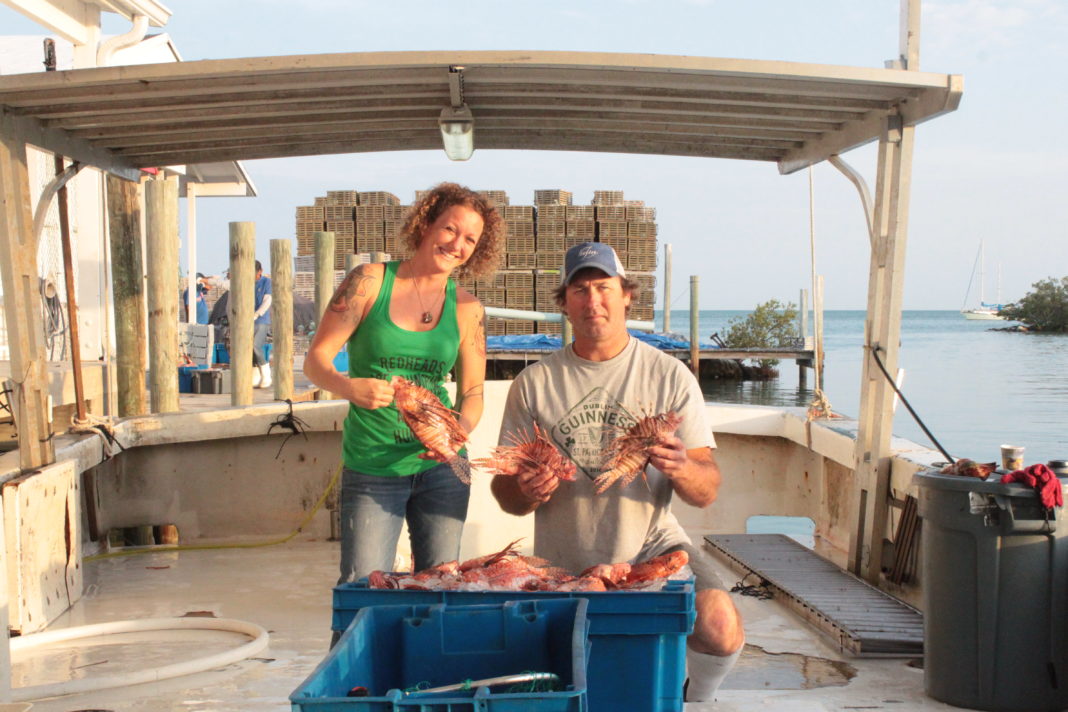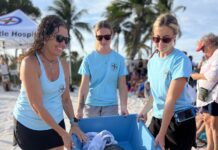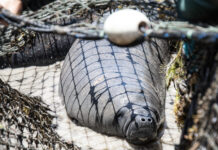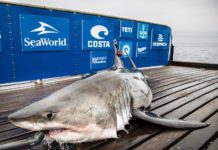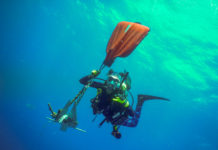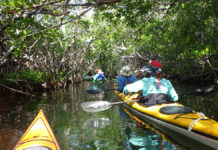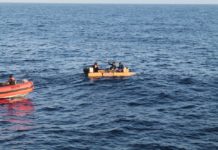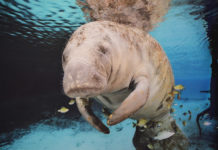“We always defer to formal regulations. Our utmost priority is to take as good a care of the ocean’s ecosystem that we can. As much as we want to get rid of lionfish, we have to make sure that we are being attentive to how different practices affect other parts of the ecosystem.” – Ashley Yarbrough, REEF lionfish derby coordinator
Lionfish are the scourge of the Florida Keys seas. Since the early 2000s, they’ve been invading local waters, devouring everything in sight. More than 120 different prey fish have been found in the bellies of the beast, and they can eat other fish that are as big as half their size. Snapper, grouper, the ornamental parrotfish and even baby lobster are no match for this venomous (not poisonous!) fish, found in abundance in the Florida Keys. Even more terrifying, a female lionfish can lay 5 million eggs in one year. Anecdotal and scientific evidence is piling up — this problem is getting much worse, very fast.
It’s legal to net them, even spear them where it’s allowed. On a great day, local spearo Rachel Bowman says she can pull up 80 to 100 pounds of lionfish. Using a scuba tank and pole spear in depths of 100 to 180 feet, she loads them into a device called a ZooKeeper and hauls them to the surface. To do so, she faces the limits of weather, available crew, and how much diving her body can physically handle.
But the simplest, most effective method for removing lionfish is to catch them in existing lobster and stone crab traps. Commercial fishermen are allowed to keep every single lionfish — called bycatch — no matter the size, and sell it … but ONLY when the traps are allowed to be in the water. For example, commercial lobster fishermen aren’t allowed to have traps in the water for four months — from April to the end of July.
“I have caught up to 1,000 pounds of lionfish in one day,” said commercial fisherman Richie Stiglitz of the Middle Keys. He runs the “Get Used To It” and fishes 5,000 lobster traps with his crew. He said the lionfish bycatch only appears in the traps in deeper waters, more than 100 feet. And while he can sell the lionfish bycatch for about $6 a pound — and buyers including local restaurants and Whole Foods are eager to have as much of the delicious fish as they can get their hands on — that’s less than the $10 a pound he earns for lobster.
And you can’t have both.
“A lionfish in the trap means no lobster. They don’t mix,” said Stiglitz.
Science backs up his statement. In a 2013 paper — “Interactions between the Caribbean spiny lobster and invasive lionfish; who displaces who?” — researchers found that when “lionfish were present in traps, the density of lobster was lower … resulting in large negative socioeconomic consequences.” One of the authors was Reef Environmental Education Foundation’s Lad Adkins of Key Largo.
But fish traps are extremely unwelcome in conservationist circles. They were outlawed in the Keys 20 years ago.
“Fish traps have a very long, sordid history. People don’t like a fish trap. I get it, having grown up in North Carolina and over-extending a resource,” said Bowman. “But wouldn’t it be great if we could get a pilot program in the Keys, and allow commercial fishermen to fish those lobster traps out of season? They are not afraid of lionfish. They’ve got the gear and the traps and boats. Let them do it. We already trust them with a commercial license.”
Across the board, organizations and agencies are very concerned about the lionfish invasion; one group in Pensacola has even invented a “lionfish killing drone.” For three years, the state Fish and Wildlife Commission has been conducting lionfish derbies, like a statewide tournament, with incentives ranging from cash to prizes to permission to harvest an extra lobster during mini-season. Outreach efforts range from schoolrooms to festivals and workshops. And the state legislature has set aside $350,000 for scientific research projects by FWC staff and outside organizations.
“There will be a large focus on innovative technologies for deep-water lionfish removal,” said Amanda Nally, a FWC spokesperson, of the funding yet to be distributed.
Bowman traveled to Tallahassee in February to have discussions with two state representatives — Rep. Halsey Beshears and Rep. Ben Albritton. (Lionfish are a statewide problem, and their territory extends from the Gulf of Mexico around the Florida peninsula to South Carolina.) She said they were receptive to the idea of using existing traps to suppress the lionfish invasion, possibly proposing new legislation.
The Florida Keys Commercial Fishermen’s Association is tackling the lionfish invasion from another angle — an exempted fishing permit issued by the National Oceanic and Atmospheric Administration for a pilot project. According to FKCFA’s Bill Kelly, they’ve been chasing it for two years. Both the NOAA Gulf of Mexico and South Atlantic Fishery Councils have recommended it for approval. It must also meet National Environmental Policy Act guidelines and also receive a special activity permit from the Florida Keys National Marine Sanctuary. The NEPA deadline is the middle of this month, and the fishermen have requested a final decision from the FKNMS by the end of the month.
“What we’re proposing is a pilot program with four test sites — three in Florida including one in the Keys, and also one in South Carolina,” said Kelly. “We would use 100 hybrid lobster traps in each area, with specific baiting techniques, to show proof of concept that we can specifically target lionfish.”
Kelly said the lionfish problem is “staggering” and has alarming statistics to share. He said one Keys commercial fisherman tallied a bycatch of 43 pounds of lionfish in 2009. In 2013, the same fisherman caught 10,000 pounds of lionfish bycatch.
Stiglitz said he hopes to receive the exempted fishing permit.
“I want to clean the bottom all summer long, so when lobster season rolls around I won’t catch as many lionfish,” he said.
“In the Keys, we have at least 10 commercial fishermen who catch more lionfish each year as bycatch, than the totals from all of the lionfish derbies in the Gulf of Mexico and South Atlantic combined.” — Bill Kelly, Florida Keys Commercial Fishermen’s Association
Read more about RACHEL BOWMAN with this week’s 20 Questions.















